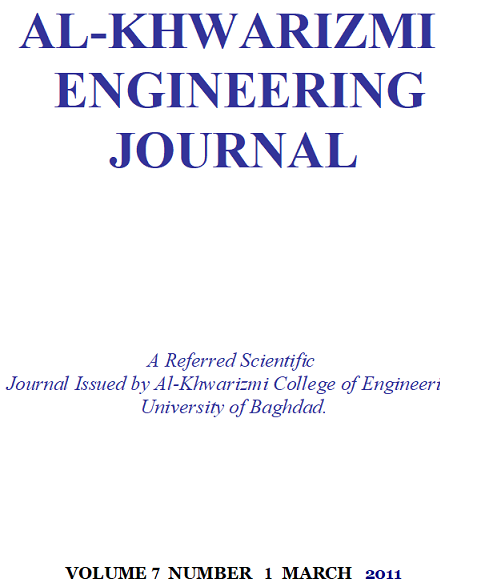Implementation of Neural Control for Continuous Stirred Tank Reactor (CSTR)
Abstract
In this paper a dynamic behavior and control of a jacketed continuous stirred tank reactor (CSTR) is developed using different control strategies, conventional feedback control (PI and PID), and neural network (NARMA-L2, and NN Predictive) control. The dynamic model for CSTR process is described by a first order lag system with dead time.
The optimum tuning of control parameters are found by two different methods; Frequency Analysis Curve method (Bode diagram) and Process Reaction Curve using the mean of Square Error (MSE) method. It is found that the Process Reaction Curve method is better than the Frequency Analysis Curve method and PID feedback controller is better than PI feedback controller.
The results show that the artificial neural network is the best method to control the CSTR process and it is better than the conventional method because it has smaller value of mean square error (MSE). MATLAB program is used as a tool of solution for all cases used in the present work.
Downloads
References
[2] Himmelblau D. M. (1978) Fault detection and diagnosis in chemical and Journal of Theoretical and Applied Information Technology © 2005 - 2008 JATIT. All rights reserved.www.jatit.org,
[3] Petrochemical processes, Elsevier, Amsterdam. Patterson D. W, "Artificial Neural Networks Theory and Applications", Prentice Hall Simon & Schuster (Asia), Singapore pg 220, (1996).
[4] Carpenter G. A and Grossberg S.),"The ART of Adaptive Pattern Recognition by Self-Organizing Neural Networks, IEEE Computer, pp 77-88, (1988).
[5] Carpenter G. A., Grossberg S. and Rosen D. B," Fuzzy ART: Fast Stable Learning and categorization of Analog Input Pattern by an Adaptive Resonance System", Neural Networks, Vol. 4, pp 59-71, (1992).
[6] Aldrich C., Moolman D. W and Van Deventer J. S; "Monitoring and Control of Hydrometallurgical Process with Self-Organizing and Adaptive Neural Net Systems", Comput. Chem. Engrg, Vol. 19 pp S803-S808, (1995).
[7] Leonard J. A and Kramer M. A," Radial Basis Function Networks for Classifying",(1991).
[8] Whitley J. R. and Davis J. F., A," Similarity-Based Approach to Interpretation of Sensor data Using Adaptive Resonance Theory", Comput. Chem. Engrg. Vol. 18, pp 637-661, (1994).
[9] Krishnaveni K and Tulasi R.D, "ANN Based Control Patterns Estimator for UPFC Used in Power Flow Power", Journal of Theoretical and Applied Information Technology, Pg 45-49, (2007).
[10] Zhang J. and Julian A.,"A Sequential training strategy for locally recurrent Neural Networks", (1994).
[11] Petia G. and Sebastiao F., "Application of Feed Forward Neural Network in Modeling and Control of a Fed-Batch Crystallization Process", Proceedings of World Academy of Science, Engineering and Technology, Vol. 12 Pg 65-70, ISSN 1307-6884, (2006).
[12] Anna Vasičkaninová and Monika Bakošová, "Neural Network Predictive Control of a Chemical Reactor", Acta Chimica Slovaca, Vol.2, No.2, 21 – 36, (2009).
[13] Luyben M. L. and Lnybem W. L.," Essentials of Process Control", McGraw Hill, New York. (1997).
[14] Haykin .S. ,"Neural Network A comprehensive foundation" second edition prentice Hall International .Inc Hamilton .Ontario .Canada, (1999).
[15] Montandon A. G., Borges R. M. and Henrique H M., "Constrained Nonlinear Model Predictive Control for Practical Application". School of chemical engineering /federal university of Uberlandia. MG. Brazil, (2007).
[16] Butrus K. M., "On-Line Computer Control of A Continuous Stirred Tank Reactor", Ph. D., Thesis, University of Technology, (1999).
[17] Jiří Vojtěšek, Petr Dostál, "Program for Simulation of a Continuous Stirred Tank Reactor in MATLAB’S GUI", 22nd European Conference on Modeling and Simulation, ECMS, (2008).
[18] Ingham, J., Dunn, I. J., Heinzle, E., Přenosil, J. E., "Chemical Engineering Dynamics. An Introduction to Modeling and Computer Simulation", Second Completely Revised Edition, VCH Verlagsgesellshaft, Wilhelm, (2000).
[19] Derar I. A., "Implementation of Neural Control for Neutralization Process", Ms. Thesis, university of technology, (2009).
Downloads
Published
Issue
Section
License
Copyright: Open Access authors retain the copyrights of their papers, and all open access articles are distributed under the terms of the Creative Commons Attribution License, which permits unrestricted use, distribution, and reproduction in any medium, provided that the original work is properly cited. The use of general descriptive names, trade names, trademarks, and so forth in this publication, even if not specifically identified, does not imply that these names are not protected by the relevant laws and regulations. While the advice and information in this journal are believed to be true and accurate on the date of its going to press, neither the authors, the editors, nor the publisher can accept any legal responsibility for any errors or omissions that may be made. The publisher makes no warranty, express or implied, with respect to the material contained herein.












